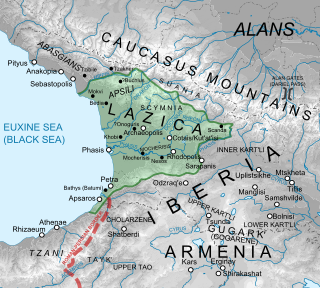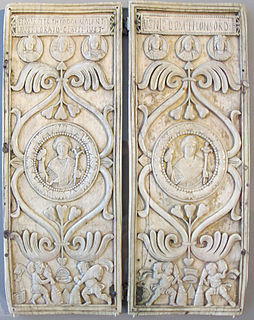Related Research Articles

Justinian I, also known as Justinian the Great, was the Byzantine emperor from 527 to 565.
Procopius of Caesarea was a prominent late antique Byzantine scholar from Palaestina Prima. Accompanying the Byzantine general Belisarius in Emperor Justinian's wars, Procopius became the principal Byzantine historian of the 6th century, writing the History of the Wars, the Buildings, and the Secret History. He is commonly classified as the last major historian of the ancient Western world.

Year 537 (DXXXVII) was a common year starting on Thursday of the Julian calendar. At the time, it was known as the Second year after the Consulship of Belisarius. The denomination 537 for this year has been used since the early medieval period, when the Anno Domini calendar era became the prevalent method in Europe for naming years.

Justin I was the Byzantine emperor from 518 to 527. He rose through the ranks of the army to become commander of the imperial guard, and when Emperor Anastasius died he out-maneouvered his rivals and was elected as his successor, in spite of being almost 70 years old. His reign is significant for the founding of the Justinian dynasty that included his eminent nephew Justinian I and three succeeding emperors. His consort was Empress Euphemia.
The Battle of Callinicum took place on Easter Saturday, 19 April 531 CE, between the armies of the Byzantine Empire under Belisarius and a Sasanian cavalry force under Azarethes. After a defeat at the Battle of Dara, the Sasanians moved to invade Syria in an attempt to turn the tide of the war. Belisarius' rapid response foiled the plan, and his troops pushed the Persians to the edge of Syria through maneuvering before forcing a battle in which the Sasanians proved to be the pyrrhic victors.

The Lazic War, also known as the Colchidian War or in Georgian historiography as the Great War of Egrisi, was fought between the Byzantine Empire and the Sasanian Empire for control of the ancient Georgian region of Lazica. The Lazic War lasted for twenty years, from 541 to 562, with varying success and ended in a victory for the Persians, who obtained an annual tribute in exchange for ending the war. The Lazic War is narrated in detail in the works of Procopius of Caesarea and Agathias.

Al-Ḥārith ibn Jabalah, was a king of the Ghassanids, pre-Islamic Arab Christians who lived on the eastern frontier of the Byzantine Empire. The fifth Ghassanid ruler of that name, he reigned from c. 528 to 569, the longest of any Christian arab ruler and played a major role in the Roman–Persian Wars and the affairs of the Syriac Orthodox Church. For his services to Byzantium, he was made patrikios and vir gloriosissimus.
The Roman–Persian Wars, also known as the Roman–Iranian Wars, were a series of conflicts between states of the Greco-Roman world and two successive Iranian empires: the Parthian and the Sasanian. Battles between the Parthian Empire and the Roman Republic began in 54 BC; wars began under the late Republic, and continued through the Roman and Sasanian empires. Various vassal kingdoms and allied nomadic nations in the form of buffer states and proxies also played a role. The wars were ended by the Arab Muslim Conquests, which led to the fall of the Sasanian Empire and huge territorial losses for the Byzantine Empire, shortly after the end of the last war between them.
Peter the Patrician was a senior Byzantine official, diplomat, and historian. A well-educated and successful lawyer, he was repeatedly sent as envoy to Ostrogothic Italy in the prelude to the Gothic War of 535–554. Despite his diplomatic skill, he was not able to avert war, and was imprisoned by the Goths in Ravenna for a few years. Upon his release, he was appointed to the post of magister officiorum, head of the imperial secretariat, which he held for an unparalleled 26 years. In this capacity, he was one of the leading ministers of Emperor Justinian I, playing an important role in the Byzantine emperor's religious policies and the relations with Sassanid Persia; most notably he led the negotiations for the peace agreement of 562 that ended the 20-year-long Lazic War. His historical writings survive only in fragments, but provide unique source material on early Byzantine ceremonies and diplomatic issues between Byzantium and the Sassanids.

Flavius Mar. Petrus Theodorus Valentinus Rusticius Boraides Germanus Iustinus, simply and commonly known as Justin, was an East Roman (Byzantine) aristocrat and general. A member of the Justinian Dynasty and nephew of Emperor Justinian I, he was appointed as one of the last Roman consuls in 540, before going on to assume senior military commands in the Balkans and in Lazica. He fought against the Slavs, the Sassanid Persians and supervised the Byzantine Empire's first contacts with the Avars. At the time of Justinian's death, he was seen as a probable successor, but was beaten to the throne by his cousin, Justin II, who exiled him to Egypt, where he was murdered.
Justinian was an East Roman (Byzantine) aristocrat and general, and a member of the ruling Justinian dynasty. As a soldier, he had a distinguished career in the Balkans and in the East against Sassanid Persia. In his later years, he plotted unsuccessfully against regent and later emperor Tiberius II.
Coutzes or Cutzes was a general of the Byzantine Empire during the reign of Emperor Justinian I.
Marcellus was a brother of Byzantine emperor Justin II and general under his uncle, Emperor Justinian I.
Hermogenes was an East Roman (Byzantine) official who served as magister officiorum, military commander and diplomatic envoy during the Iberian War against Sassanid Persia in the early reign of Emperor Justinian I.
Pompeius was a politician of the Eastern Roman Empire and relative of the Emperor Anastasius I.
Gubazes II was king of Lazica from circa 541 until his assassination in 555. He was one of the central personalities of the Lazic War (541–562). He originally ascended the throne as a vassal of the Byzantine Empire, but the heavy-handed actions of the Byzantine authorities led him to seek the assistance of Byzantium's main rival, Sassanid Persia. The Byzantines were evicted from Lazica with the aid of a Persian army in 541, but the Persian occupation of the country turned out to be worse, and by 548, Gubazes was requesting assistance from Byzantium. Gubazes remained a Byzantine ally during the next few years, as the two empires fought for control of Lazica, with the fortress of Petra as the focal point of the struggle. Gubazes eventually quarrelled with the Byzantine generals over the fruitless continuation of the war, and was assassinated by them.
The Perpetual Peace, signed in 532 between the East Roman (Byzantine) Empire and Sassanid Persia, was a peace treaty of indefinite duration, which concluded the Iberian War (527–531) between the two powers. It heralded a period of relatively cordial relations, but lasted only until 540, when hostilities resumed over the control of Lazica.
Alexander, known by the title comes, was a Byzantine diplomat. He was active in the reign of Justinian I. The main sources about him are Procopius, John Malalas and Theophanes the Confessor.

The Battle of Thannuris (Tannuris) was fought between the forces of the Eastern Roman (Byzantine) Empire under Belisarius and Coutzes and the Persian Sasanian Empire under Xerxes in summer 528, near Dara in northern Mesopotamia. As they were trying to build a fortress in Mindouos, the Byzantines were defeated by the Sasanian army. Belisarius managed to flee but the Sasanians destroyed the buildings. Despite their victory, the Persians suffered heavy losses, angering Kavadh I, the Sasanian king of Persia.
Mahbod, was a 6th-century Iranian ambassador and military officer from the House of Suren, who was active during the reign of the Sasanian shahanshahs Khosrow I and Hormizd IV.
References
- 1 2 Martindale, Jones & Morris 1992 , pp. 639–640.
- 1 2 Procopius. Persian War, 26.5–26.12.
- ↑ Maas 2005 , p. 488.
- ↑ Greatrex & Lieu 2002 , pp. 97–102.
- ↑ Marcellinus Comes & Croke 1995 , pp. 40–41 (1 Sept. 536 – 31 Aug. 537).